February 15, 2024—With Chesapeake Bay oyster recovery at a crucial point, building on current momentum will increase resiliency to climate change in the region while creating multiple benefits for people and the environment, according to a new report released today by the Chesapeake Bay Foundation. Read Press Release
Why Are Oysters and Oyster Reefs Important for the Chesapeake Bay?
Eastern oysters, Crassostrea virginica, are a critical component of the Chesapeake Bay ecosystem, known as a keystone species. With their clean, hard surfaces and intricate three-dimensional structure, large oyster reefs attract a wide variety of life. They provide food, cover, and habitat for hundreds of small and juvenile fish, crabs, shrimp, and other species, which in turn provide prey for larger fish and crabs.
These shellfish are also prolific filter feeders. They remove light-blocking algae from Bay waters and help remove excess nutrients like nitrogen and phosphorus. And healthy reefs are home to other filter feeders, as well, including barnacles, encrusting bryozoans, sea anemones, and hooked mussels.
Without oysters, the quality of the Bay ecosystem suffers. Without their filtration clearing the water for light to penetrate, bay grasses can struggle to grow. Without healthy grass beds and reef habitat that provide refuge from predators and ample prey to feed on, juvenile fish and crabs may not survive to adulthood. In other words, more oysters equal better water quality, more fish and crabs, and healthier underwater grass beds.
A thriving population affects humans, too. Without it, the Bay's traditional seafood industry will continue to struggle. The good news is that when we bring back oysters, all of their benefits come back with them.
What Happened to Oysters in the Chesapeake Bay?
Currently, oyster populations in the Bay are at a small fraction of their historical population size. The storied shellfish and their vertical reefs once posed navigational hazards to early Europeans sailing in the Bay. Their abundance created a Chesapeake oyster-harvesting industry that became the largest in the world by the late 19th century.
But decades of overharvesting, pollution, and disease have contributed to the decline of populations in the Bay. Destructive harvesting techniques led to the loss of roughly three-quarters of the Bay’s reefs between 1860 and 1920. As the population of the watershed continued to grow, so did pollutants. Due to an overabundance of nutrients like nitrogen and phosphorus, Bay waters began to grow too much algae, which led to large dead zones—areas without enough oxygen to sustain life. Loss of forest land and inadequate erosion control left oyster beds silted over and oyster larvae with no place to set. Beginning in the 1950s, the Bay was hit with two diseases—MSX and Dermo—that are caused by parasites that attack and frequently kill the mollusks, though they are harmless to people. Together, continued overharvesting, pollution, and disease devastated the Bay’s populations.
What Is the Current State of Oyster Populations in the Chesapeake Bay?
In Maryland, the market-size population (those above three inches) and spat (juvenile oysters) estimates increased according to the June 2021 update to Maryland's Oyster Stock Assessment by the Maryland Department of Natural Resources. In fact, spat estimates increased to the highest level in the previous 20 years. Even with population growth, however, some areas continue to experience overfishing.
In February 2023, Virginia's evaluation found that oyster stock was at its best condition in a generation, and even extended the season for the first time since 1987-88. Virginia's total wild oyster harvests has remained stable at around 600,000 bushels for the past several years, partly due to a rotational harvest system. This system reduces pressure on certain harvest bars by only opening them to harvest once every three years. In addition, a state supported replenishment program helps to plant shell on harvest areas, increasing habitat for baby oysters (spat) to attach and grow.
What Is Being Done to Restore Oysters Reefs to the Bay?
In 2014, Maryland and Virginia each committed to restoring oyster populations and reef habitat in 11 rivers by 2025. Areas in which this large-scale oyster restoration has been carried out to bring back reefs and restore their function in the ecosystem are starting to see the benefit of increasing populations and stable or growing reef habitat.
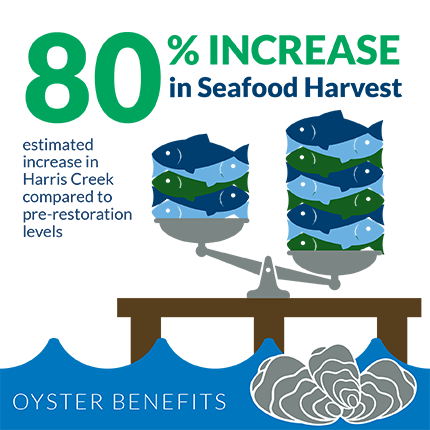
Restored reefs in Harris Creek, on Maryland’s Eastern Shore, can now filter the entire volume of the creek in less than 10 days during the summer. Each year, the reefs are estimated to remove an amount of nitrogen equivalent to 20,000 bags of fertilizer—a service valued at more than $1.7 million.
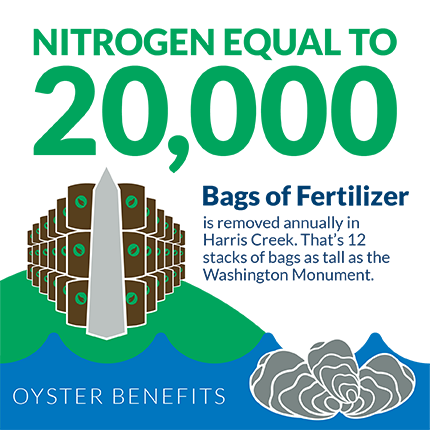
Pollution, habitat loss, overharvesting, and disease are the main factors limiting oyster recovery in the Chesapeake Bay. Full implementation of the Chesapeake Bay Clean Water Blueprint, the science-based plan to restore the Bay to health, is the primary means by which we can achieve improved water quality and reduce the threats to this crucial shellfish's survival.
Until populations improve enough to replenish reefs on their own, we will need to continue restoration efforts by placing shell and juvenile oysters on the bottom to kickstart the process.
How Can I Help Oysters Recover in the Chesapeake Bay?
There are many ways you can help us restore oyster populations and improve water quality in the Bay:
- SPREAD the word to your neighbors and friends about how important oysters are to the health of the waters and wildlife of the Bay.
- RECYCLE your oyster shells through CBF’s shell recycling program and support restaurants that participate in shell recycling programs—shell availability is one of the biggest limiting factors in oyster restoration.
- SUPPORT local oyster farmers by buying directly from local farms or at farmers’ markets.
- STAND UP for oysters by signing our pledge.
- SHARE your support for oyster recovery—and especially the unique value of vertical oyster reefs—by writing a letter in your local paper or to state officials responsible for oyster restoration.
- VOLUNTEER with CBF's active oyster restoration program by building reef balls, cleaning shells, or becoming an oyster gardener. Visit cbf.org/oysters for more info.
- MAKE A DONATION to support our restoration program by giving the gift of oysters from our online Giving Catalog at cbf.org/catalog.
From Our Blog
-
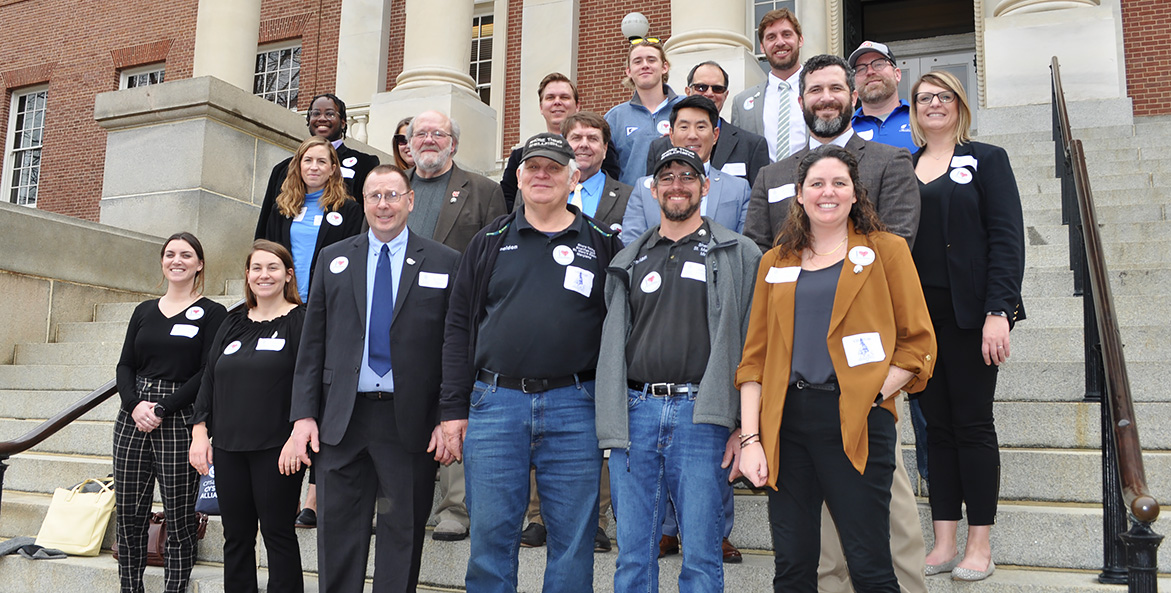
Oyster Advocates Fight for Better Aquaculture Lease Process
March 15, 2023
A delegation of environmental advocates, aquaculture operators, and scientists met with legislators to support important aquaculture bills being considered in the Maryland General Assembly.
-
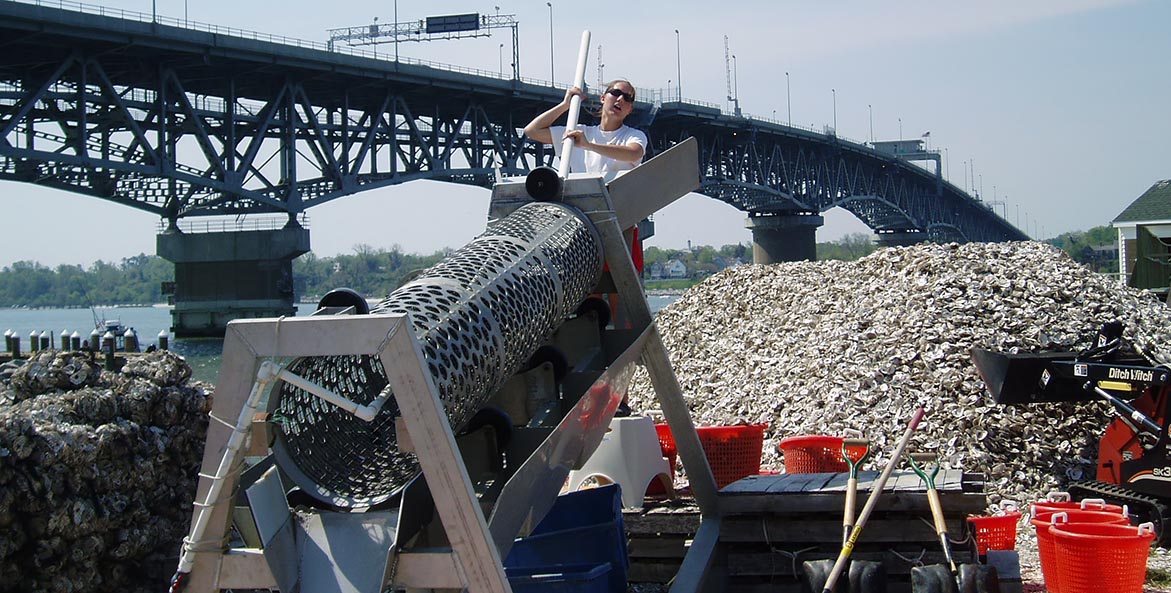
Virginia Backs Oyster Shell Recycling with New Fund
March 7, 2023
The best surface for baby oysters to grow on is the shell of another oyster. Virginia's adoption of a fund to help recycle oyster shell will give a much needed boost to this natural resource.
-
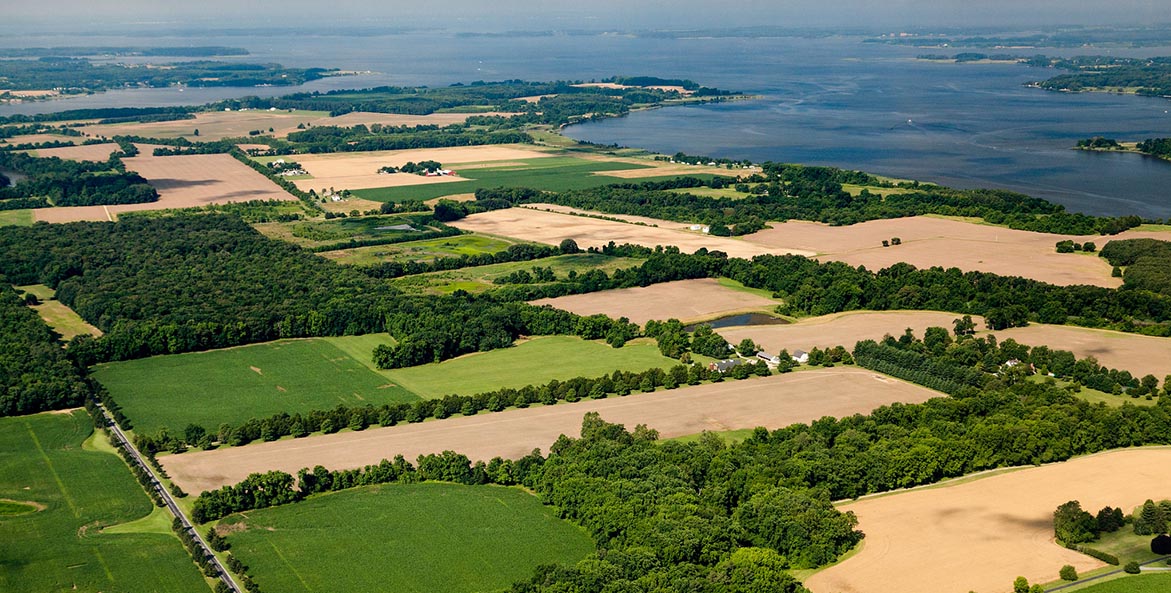
Save the Bay News: State of the Bay, Oyster Milestones, and Exploring Your Watershed
January 27, 2023
What does the 2022 State of the Bay mean for the long-term health of the Chesapeake and the communities that depend on it? Dive into the big takeaways from the recently released report and more stories about the state of the Bay.
| Items 10 - 12 of 20 | Previous | 1 | 2 | 3 | 4 | 5 | 6 | 7 | Next |
Multimedia
-
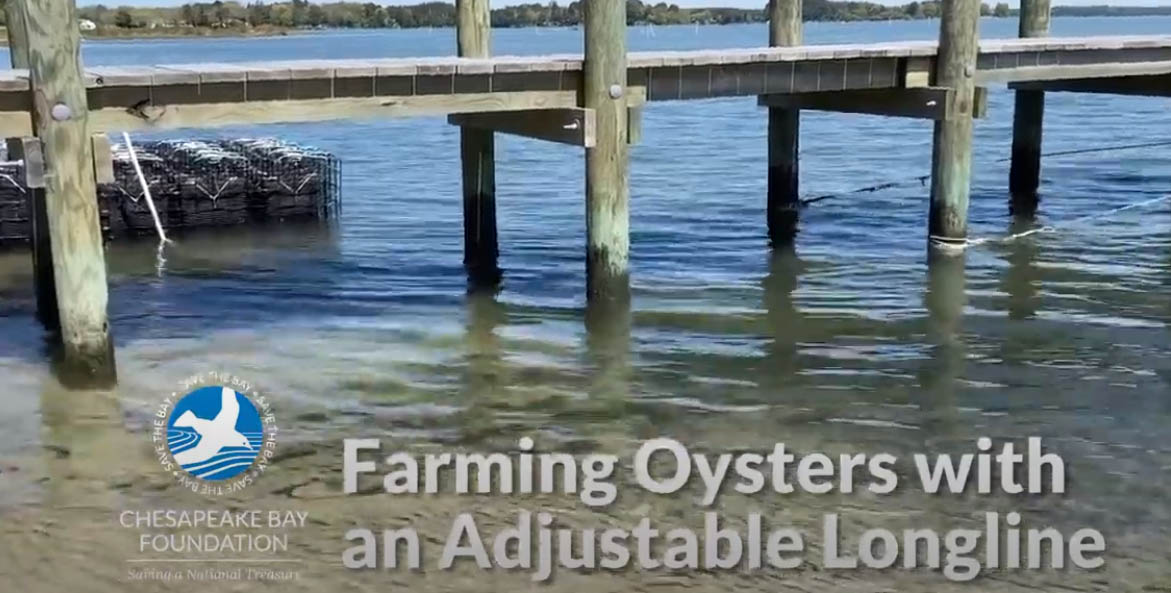
Farming Oysters with an Adjustable Longline
19 Jun 2020 00:01:53Alex Lambert of Lambert Shellfish demonstrates the adjustable longline technique used in oyster aquaculture.
-
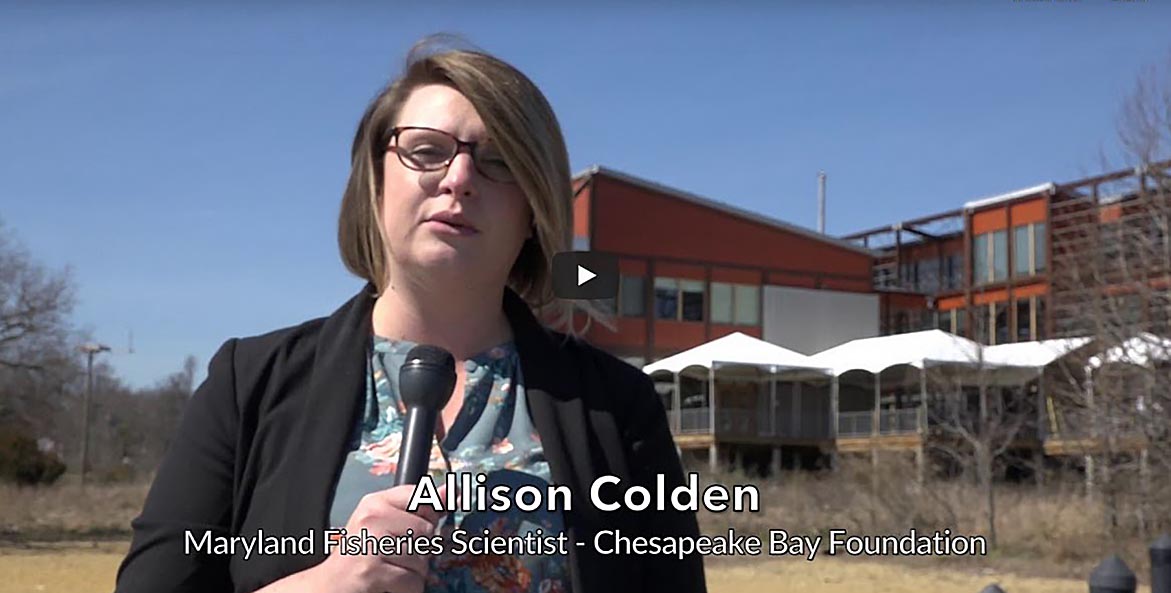
The Value of Oyster Aquaculture in Maryland
01 Apr 2020 00:02:02Oyster aquaculture is not only helping the economy throughout the Bay region, it's also helping save the Bay. Learn how Maryland's oyster aquaculture industry has grown and its impact on the Bay and the economy from CBF's Maryland Fisheries Scientist, Allison Colden.
-
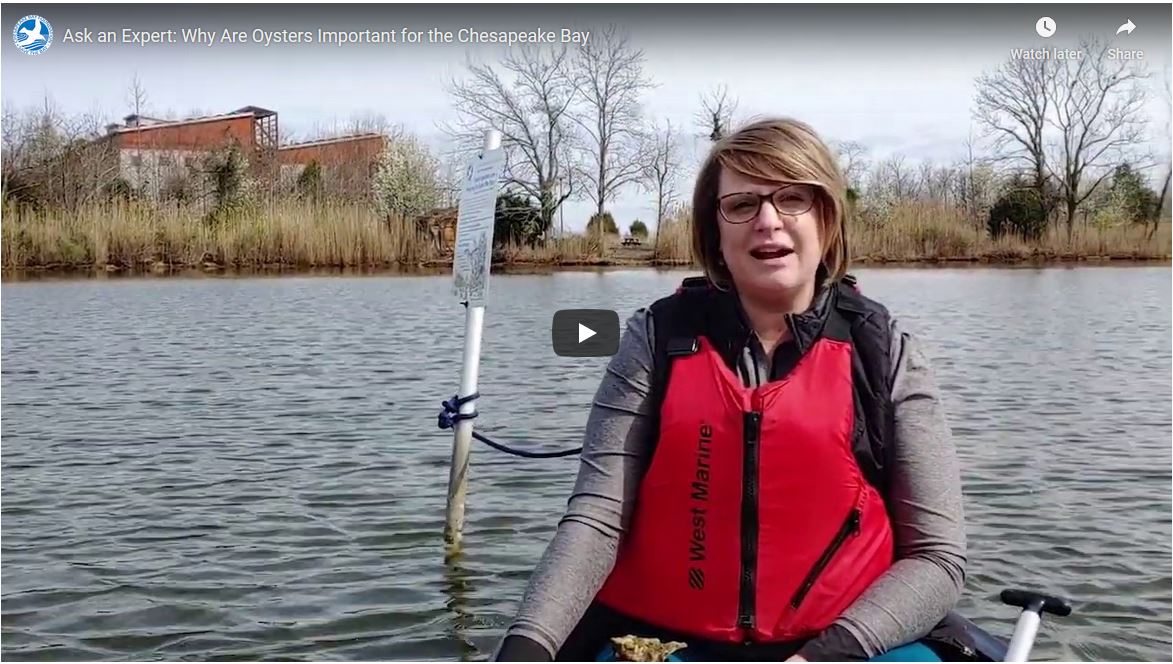
Ask an Expert: Why are Oysters Important for the Chesapeake Bay?
25 Mar 2020 Episode 1 | 00:06:46Why is an oyster hard to shuck? How do young oysters choose their homes? What happens when an oyster filters water? CBF’s Maryland Fisheries Scientist Allison Colden gets up close and personal with the Bay’s famous bivalve.
| Items 10 - 12 of 20 | Previous | 1 | 2 | 3 | 4 | 5 | 6 | 7 | Next |


